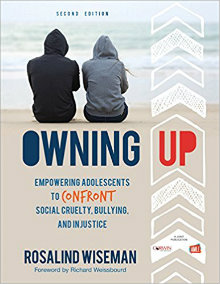Help Kids Confront Bullying and Injustice
Owning Up: Empowering Adolescents to Confront Social Cruelty, Bullying, and Injustice, Second Edition
By Rosalind Wiseman
(Corwin, 2017 – Learn more)

I’ve always bristled at the term “character education,” especially when it comes to bullying and peer pressure, because it implies that young adolescents have deficient character traits and educators need to show them how to behave.

As a result, the conversations this book encourages educators to have with teens are much more meaningful – and may be much more uncomfortable for adults who are used to lecturing around values.
Most of this book is a straight-to-photocopier unit guide with discussion strategies, teaching points, and recommended activities to teach a variety of topics from harassment to unhealthy relationships. Wiseman invites educators to pick and choose activities or modify as needed.
A realistic tool for addressing social conflict with peers
Wiseman introduces the SEAL strategy for empowering peers to address each other. The process does not show students how to behave or how to make choices, but instead gives a guide for how to speak up in a way that validates the experiences of the person who is initiating conversation and the person receiving conversation. The acronym (p. 47) stands for:
Stop: Breathe, observe, and ask yourself what the situation is about. Decide when and where you can talk to the person so the person will be most likely to listen to you.
Explain: Take your bad feelings and put them into words — be specific about what you don’t like and what you want to happen instead. You realize you are making a request, so you know you may not get what you want. But at least you are being clear with yourself and others.
Affirm and Acknowledge: State your right to be treated with dignity by the other person, and your responsibility to do the same in return. If appropriate, acknowledge your part in contributing to the situation.
Lock:
- Lock in the friendship: Decide to make the friendship stronger by talking about the problem.
- Take a break: Decide to take a break from the friendship but agree to talk later about reestablishing the friendship.
- Lock out the friendship: As a last resort, when you really feel that your feelings and personal boundaries aren’t being respected, decide to end the friendship.
These steps encourage victims and bystanders to be honest about their feelings and encourage them to make a choice with consequences.
Realistic anecdotes allow students to think through situations with complexity
One of the strengths of this book is the number and variety of anecdotes and simulations that introduce possibly problematic adolescent behavior for discussion. These anecdotes include straight and gay crush and romantic scenarios and instances of teens sending flirty and embarrassing images to each other.
Wiseman also encourages teens to view behavior in light of gender norms. Early on in the curriculum, she introduces “Act Like A Girl” boxes and “Act Like a Boy” boxes where students name encouraged and ideal behaviors of both genders. By solidifying these gender expectations early on, students can make more nuanced observations about different kinds of harassment. For example, if girls are “supposed to” like attention from boys and boys are “supposed to” pursue girls, it is harder for girls to speak up about unwanted attention from boys.
Do these anecdotes and lessons ring true to your school community and climate?
It’s possible that these activities and anecdotes will not be relevant for all school communities. For example, the teaching guide encourages educators to return to gender, but it does not give a lot of guidance to talking about race. It also doesn’t give guidance towards comments about immigrants or immigration status, nor does it address intimidation and bullying at home.
For some school communities, making this curriculum work might be as easy as providing a few more anecdotes that are based on real experiences from students. For other schools, this curriculum may need to be supplemented with other books and activities.
Amy Estersohn is a middle school English teacher in New York and a 2016 recipient of the NCTE/ALAN Gallo Grant. She blogs at Teaching Transition and can be found at @HMX_MSE.
Read author Rosalind Wiseman’s MiddleWeb article, “Helping Students Thrive in “Cultures of Dignity” here.



































Sounds like a good book for our times. Thanks for the review, Amy.